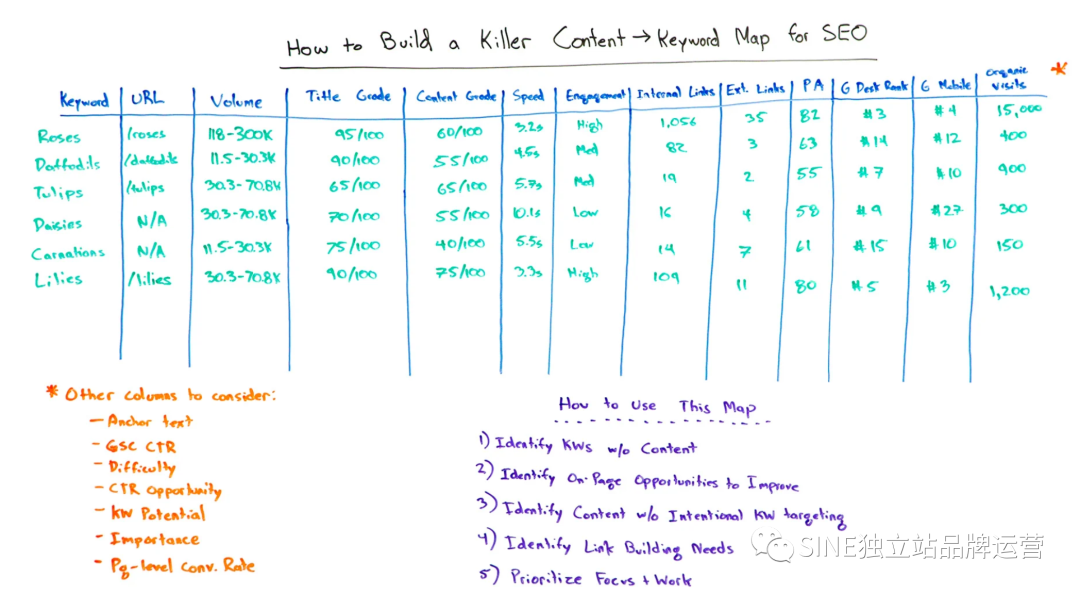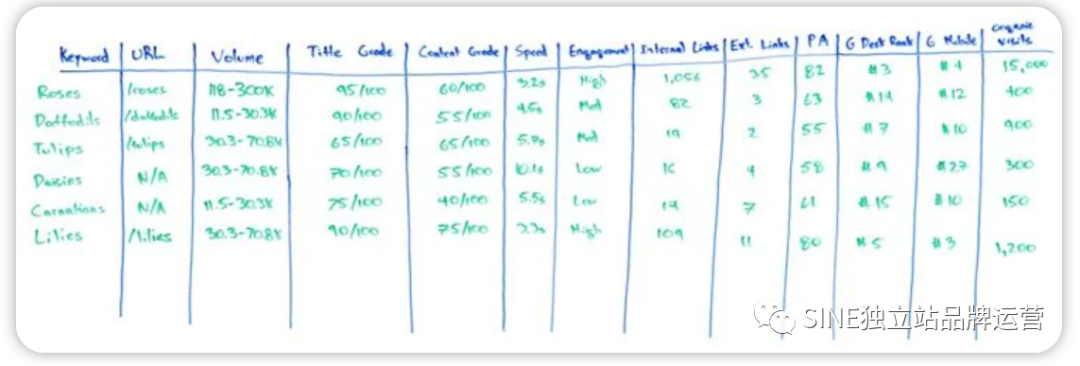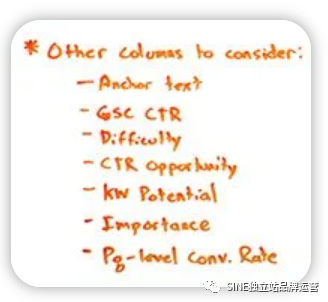您網(wǎng)站上的內(nèi)容并非有意針對任何關(guān)鍵字。但是,您如何識別這些機(jī)會,最重要的是如何利用它們?

本周我們將討論如何構(gòu)建一個殺手級的內(nèi)容到關(guān)鍵字的映射。現(xiàn)在,這幾乎是每個 SEO 在對網(wǎng)站進(jìn)行審計時都會做的事情,無論是在內(nèi)部還是作為承包商或代理顧問。
我們試圖在這里得到的是一張圖片:這是我們試圖定位的所有關(guān)鍵字。這是我們擁有的所有內(nèi)容,也許我們有所有這些內(nèi)容的關(guān)鍵字。也許其中一些內(nèi)容沒有關(guān)鍵字,諸如此類。我們正在嘗試將這些映射在一起,以便我們知道哪些需要優(yōu)化,需要構(gòu)建哪些新內(nèi)容,需要針對哪些關(guān)鍵字來匹配哪些內(nèi)容,以及所有這些類型的內(nèi)容。這就是我們?nèi)绾未_定 SEO 在新網(wǎng)站、新活動時應(yīng)該做的優(yōu)先事項(xiàng)和工作。
SEO制圖

所以我在這里所做的是構(gòu)建一個大的,但實(shí)際上這并不像您想象的某些內(nèi)容到關(guān)鍵字的映射那樣完整。我已經(jīng)看到它們的列數(shù)是這些的兩倍,我相信很多正在觀看的人都會說,“哦,伙計,蘭德,我的地圖上還有更多。”
通常這是在 Excel 中完成或在 Google 電子表格中完成。任何一個都可以正常工作。不幸的是,目前沒有很好的軟件可以做到這一點(diǎn)。如果您在企業(yè)方面,您可以使用Moz 之類的工具或工具(例如Searchmetrics或Conductor)來獲取大量此類數(shù)據(jù)。你可以從大量不同的地方提取數(shù)據(jù),或者是那邊的統(tǒng)計數(shù)據(jù),無論是什么,OnPage.org。
列
但是您要在這里構(gòu)建的內(nèi)容基本上是我所有的關(guān)鍵字都映射到我的所有 URL。有時你可能會。. . 事實(shí)上,如果你正在做一個綜合性的工作,你應(yīng)該找到一些你沒有一些關(guān)鍵詞的 URL 的地方,因?yàn)橐恍╆P(guān)鍵詞還沒有被定位,但你仍然想為它們排名。您可能應(yīng)該有一些沒有關(guān)鍵字的 URL。從本質(zhì)上講,您還沒有故意將關(guān)鍵字定位到該頁面,這實(shí)際上可能會幫助您確定優(yōu)先級并嘗試執(zhí)行其中的一些操作。
然后你會有這樣的事情:這有多少搜索量?您將嘗試估計或使用工具為您的標(biāo)題、內(nèi)容、可能是 URL 本身、加載速度和參與度打分。參與度可以是每次訪問的網(wǎng)站或頁面的瀏覽率或時間,也可以是所有這些內(nèi)容的組合。
您可能正在查看頁面的內(nèi)部和外部鏈接。內(nèi)部鏈接說,“內(nèi)部鏈接有多好?我在那里有機(jī)會嗎?”?外部鏈接說,“我排名還是不排名,因?yàn)槲覜]有外部鏈接指向這里?”
我可能會查看諸如頁面權(quán)限之類的內(nèi)容來嘗試匯總這些內(nèi)容、Google 桌面和 Google 移動排名,以及該頁面從搜索引擎收到的自然訪問。

現(xiàn)在,您可以考慮添加更多的列。您可以添加以下內(nèi)容:
錨文本,如果你要分析你的內(nèi)部和外部的錨文本。
Google Search Console中某些關(guān)鍵字的點(diǎn)擊率并將該數(shù)據(jù)添加到其中。我們都知道 Google Search Console,不是非凡的數(shù)據(jù),但有時可能很有用。
如果您嘗試優(yōu)先考慮大型關(guān)鍵字研究功能,例如Keyword Explorer 中的內(nèi)容,您可能會有更多關(guān)鍵字驅(qū)動的指標(biāo):
關(guān)鍵詞難度
點(diǎn)擊率機(jī)會
重要性得分,您的自定義重要性得分,您的潛力。您可能會根據(jù)這些類型對這些進(jìn)行不同的排序。
頁面級轉(zhuǎn)化率。這對在我的網(wǎng)站上轉(zhuǎn)換的內(nèi)容有多大貢獻(xiàn)?它直接轉(zhuǎn)換的效果如何?那些東西。
繼續(xù)路線
所以現(xiàn)在你已經(jīng)有了這個大的內(nèi)容到關(guān)鍵字的映射。“蘭德,我為什么要建造這個?”?好吧,看,這張地圖可以讓你做一堆非常重要的事情,比如:
識別沒有內(nèi)容映射到它們的關(guān)鍵字。基本上就是說,“嘿,如果我想定位這個關(guān)鍵字,我最好構(gòu)建一些內(nèi)容。”?這是你需要做的工作。
確定頁面上的改進(jìn)機(jī)會。因此,您可能會查看某些內(nèi)容或標(biāo)題等級。你可能會去匹配排名,你可能會說,“等一下。我排名第 10。我的內(nèi)容評分只有 40 分(滿分 100 分)。該死,我可以很快改進(jìn)。我可以把那個頁面變成一個通過投資一些頁面優(yōu)化,效果會更好。”
或者,例如,您可能會說,“嗯,我在一堆這些指標(biāo)上做得很好,但是男孩,頁面加載速度真的很糟糕。看,我可以在桌面與移動排名中看到這一點(diǎn)。我' “我在桌面上的排名比在移動上好得多。也許加載速度是原因之一。”?我可以查看其他頁面改進(jìn),例如“哦,伙計,參與度太低了。我敢打賭,低參與度會降低我的排名潛力。”?好吧,那兩個。識別沒有關(guān)鍵字定位的內(nèi)容。所以我可能會在這里發(fā)現(xiàn)我有類似 /flowers 的東西,它在這里提供了我所有不同的選項(xiàng),但我沒有故意選擇我的目標(biāo)。我賣花送貨嗎?我應(yīng)該瞄準(zhǔn)那個嗎?我是賣溫室用花還是在你家后院種花?我應(yīng)該瞄準(zhǔn)那個嗎?我這里的關(guān)鍵詞是什么?射擊,我還沒有建立一個。通常,當(dāng)您審核一個站點(diǎn)時,您會發(fā)現(xiàn)大量 URL 故意不針對特定關(guān)鍵字,但應(yīng)該是。您需要做的就是進(jìn)行一些優(yōu)化工作,以幫助這些 URL 定位它們應(yīng)該定位的關(guān)鍵字。
確定鏈接建設(shè)需求。所以我可能會看這里,我可能會說,“嗯,我的外部鏈接,哦,那太糟糕了,我的排名有點(diǎn)反映了這一點(diǎn)。我需要做一些鏈接建設(shè)。比如,那個頁面不會排名。即使它在頁面上做的很好,沒有這個它就不會排名。
優(yōu)先考慮并專注于您的工作,以便您在完成此審核后可以做最重要的事情,并且您可以真正推動 SEO 的發(fā)展。
如果您有很棒的想法或在內(nèi)容到關(guān)鍵字的地圖中做了很棒的事情,我很樂意看到它們。請把它們留在評論中。隨意鏈接到事物。如果您想上傳地圖,請展示您的地圖。我很想看到查看列以及您使用此地圖的方式。希望在未來,也許我可以說服 Moz Pro 軟件人員為您構(gòu)建這個。;-)
Gianluca Fiorelli
Answering to your questions:
1) Do you use this methodology? If not, what do you use to prioritize which SEO work (for specific pages/keywords) to do next?
I do... a lot.
Actually, along with crawling the site and analyzing its log file, this is the third basic analysis I do, and I use it for then elaborating:
Content audit and therefore strategy, where I usually:Consider how to improve the effectiveness of existing content (if not changing entirely its purposes; for instance changing the nature of the keywords it is targeting from informational to transactional or from top to middle of funnel or bottom of the funnel);Try to individuate gaps and missed opportunities, so to suggest the creation of content (or even sections) that are missing in order to enlarge the keywords targeted by the site.On Page Analysis and Optimization.
2) If you do build spreadsheets like this, what tools do you currently use to get the data? How much of it is manual?
Information retrieval is mostly based on tools, many of which you cited in the WBF. I'd add SISTRIX to the tools mix in the discovery phase and SEMRush and Similarweb, these two also for discovering what keywords competitors are targeting, which my site is not.
Another tools I use, then, is URL Profiler, which is great - thanks to its ability to connect to many tools via API - for retrieving URL based metrics.
Finally I consolidate all the collected data in a Excel file for working.
3) What columns or what types of data do you currently use (or what would you love to have in a tool that did this for you if Moz or another software provider built it)?
You listed almost all the columns I use too, both in the spreadsheet and the suggested columns below it.
Of the suggested ones, I would add the "Impressions" metric that GSC offers, because in combination with rankings and CTR, it can tell us if a Search Snippet is not offering the desired results.
Another column I add is the "Level" one, meaning with level in what level of the site the mapped URL is present. This data can be useful especially for understanding if the page is not ranking as well as its maybe good optimization would make us think of, hence considering if a better internal linking from higher levels of the site could give it that boost we are aiming for the URL in the SERPs.
In some cases, I also create a column where I specify what phase of the funnel the keyword and page are targeting (TOFU, MOFU, BOFU)
Finally, I usually create an Excel file with 3 spreadsheets' tabs:
1) All the keywords;
2) Branded keywords;
3) Non Branded keywords.
P.D.: setting reminders in my Calendar for asking you and the Moz Pro product team if you started working on a product like this every now and then :D.
來源:moz
文章為作者獨(dú)立觀點(diǎn),不代表DLZ123立場。如有侵權(quán),請聯(lián)系我們。( 版權(quán)為作者所有,如需轉(zhuǎn)載,請聯(lián)系作者 )

網(wǎng)站運(yùn)營至今,離不開小伙伴們的支持。 為了給小伙伴們提供一個互相交流的平臺和資源的對接,特地開通了獨(dú)立站交流群。
群里有不少運(yùn)營大神,不時會分享一些運(yùn)營技巧,更有一些資源收藏愛好者不時分享一些優(yōu)質(zhì)的學(xué)習(xí)資料。
現(xiàn)在可以掃碼進(jìn)群,備注【加群】。 ( 群完全免費(fèi),不廣告不賣課!)






